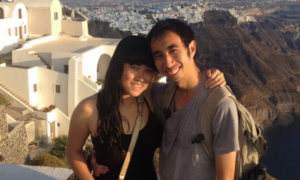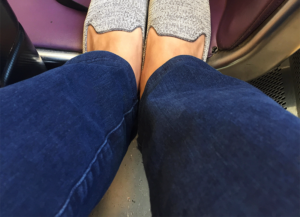 Can you imagine living on 44 cents a day?
Can you imagine living on 44 cents a day?
Kristy Shen doesn’t need to imagine it. She lived it.
Kristy grew up in rural China, where 85 percent of the population lived in abject poverty.
When she was eight, her family emigrated to Canada. In Kristy’s eyes, her family’s newfound ability to buy a can of Coca-Cola meant that they had “made it.” Kristy loved her Coke can so much that she turned it into a toothbrush holder.
Years later, Kristy met Bryce Leung at university, where they were classroom lab partners. They married, settled in Toronto and started saving for a downpayment on a house.
When their down payment savings hit $500,000, they started to question the wisdom of dumping their money into an expensive personal residence.
Fueled by curiosity, they stumbled down the financial independence rabbit hole. After countless hours of research and number-crunching, they ditched their plan to buy a house and invested their $500,000 into the stock and bond market. Around seven years later, their net worth reached $1 million.
Kristy and Bryce achieved financial independence at age 31 and 32, respectively. They quit their jobs in 2015 and they’ve spent the last four years traveling the globe on an annual budget of $40,000.
They don’t worry about running out of money. They didn’t sacrifice their identities when they left their jobs. They didn’t lose their community.
Instead, the opposite happened. Their portfolio increased to $1.4 million. They have new, exciting identities. Their community has quadrupled.
In this episode, Kristy and Bryce explain how they’ve created security and flexibility as early retirees.
Here are several of their tips:
#1: Befriend the Scarcity Mindset
As a result of growing up in poverty, Kristy developed a scarcity mindset, which she and Bryce harnessed their advantage.
Bryce says:
“The scarcity mindset … where it’s the most helpful is it causes you to not waste money, right? … When you don’t have a lot of [money], and you’re worried about where your next meal is coming from, scarcity makes you [more efficient].”
According to the couple, viewing money as scarce:
- Prevents them from taking money for granted
- Motivates them to waste less
- Fosters a sense of gratitude
#2: Persevere Through Market Downturns
Kristy and Bryce began investing one year before the stock market crashed. Rather than panic, they continued investing throughout the Great Recession, holding steady with their contributions and maintaining their asset allocation.
Kristy says:
“It really is trusting the math … you realize that yes, the stock market is falling, and yes, I’m freaking out and having a panic attack. But if you trust the system and you continue buying as its falling – we actually covered our money in less than two years.”
Kristy and Bryce split their investments 60/40 between equities and bonds. They rebalanced by selling bonds and investing in stocks during the financial crisis. By doing so, they picked up more stock units during the downturn, and as a result, their portfolio quickly recovered.
This experience taught them that investments recover over time. Market downturns no longer scare them.
#3: Debunk Your FIRE Fears
Kristy points out that many people in the Financial Independence Retire Early (FIRE) movement worry about three things:
“One is loss of money, one is loss of community, and loss of identity. A lot of the times your network comes from your coworkers – what’s going to happen when you don’t have that community anymore?”
None of these fears came true for Kristy and Bryce.
Their portfolio increased from $1 million to $1.4 million (using the strategy outlined below). They created new identities after retiring. Their community quadrupled. They have friends around the world from the FIRE movement and from their travels.
Financial independence gives them the freedom to explore new interests (like fiction writing) without fear of failure because they no longer need to rely on income from a job. This helps them craft new identities and explore novel ideas.
#4: Identify and Hedge Against Points of Failure
Kristy and Bryce use three strategies to reduce the risk of overspending from their portfolio in early retirement:
- Yield shield
- Cash cushion
- Geoarbitrage
Let’s tackle the purpose and benefit of each strategy below.
4a) Yield Shield
What if the stock market crashes at the start of your early retirement? How do you minimize the risk of converting paper losses into real losses during those critical first few years?
That’s where a yield shield comes in.
“When sequence of returns hits you, the mechanism of failure happens if you’re forced to sell at a loss … You go into retirement, the portfolio goes down, and then you have to sell stocks and bonds when everything is at a lower value in order to fund your lifestyle … By increasing your yield, you avoid that.”
Kristy and Bryce achieved this by shifting their portfolio from stocks and bonds into higher-yield assets at the start of their retirement. They invested in preferred shares, real estate income trusts (REITs), higher dividend yielding stocks, and corporate bonds. This shift increased the yield of their portfolio from 2 percent to 3.5 percent, such that they received $35,000 per year in dividends and interest income per year from their $1 million portfolio.
4b) Cash Cushion
The second step of their system is to create a cash cushion that works in tandem with the yield shield.
While most people recommend keeping a few years’ worth of living expenses in a savings account, Kristy and Bryce take a different approach.
“What we realized when we paired this with the yield shield is that you don’t actually need to keep the full amount of how much cash you need to weather a storm. You only need the difference between how much cash you need to live on and what your yield shield is providing you.”
Kristy and Bryce live on $40,000 per year. Their portfolio yields $35,000 per year. They need $5,000 per year to make up the difference.
This means that saving a cash cushion for five years of living expenses requires $25,000 (the annual difference, multiplied by five) as opposed to $200,000 (their cost-of-living over five years).
This strategy allows more of their money to stay in the market where it can continue to grow.
4c) Geoarbitrage
Kristy and Bryce visited over 10 countries last year. They recorded this interview from Thailand. They’ve embraced the nomadic lifestyle in early retirement and they live comfortably on $40,000 per year.
Travel isn’t as expensive as you might think, they say, and long-term travel in low-cost areas can reduce your living expenses.
“The cost of travel kind of acts like a portfolio in that if you balance expensive places like the UK or Denmark with inexpensive places like Thailand or Poland … it’s actually pretty easy to live on $40,000 a year while traveling the world…”
Kristy and Bryce have the flexibility to drastically reduce their living expenses by spending months in low-cost-of-living countries, where they can maintain a great quality of life for significantly less than the amount they’d spend in the U.S. or Canada. They recommend thinking about travel as a cost-savings strategy.
Resources Mentioned:
- Quit Like a Millionaire, by Kristy Shen and Bryce Leung
- Little Miss Evil, by Kristen Shen and Bryce Leung (children’s book)
- Chautauqua – Above the Clouds Retreats
Thanks to our sponsors!
Radius Bank
Do you want your money to make more money? Then check out Rewards Checking, from Radius Bank. You earn 1.00% APY on balances of $2,500 and up, there are no fees, and it offers unlimited one percent cash back on debit card purchases. To get started, head over to radiusbank.com/paula.
Freshbooks
Save time by using Freshbooks, an easy-to-use, cloud-based accounting system that takes the stress and hassle out of bookkeeping and, especially, invoicing. You can create an invoice in a few seconds, and Freshbooks’ automated system will handle the rest. Visit Freshbooks.com/paula for a free 30-day trial. Please mention this show when they ask how you heard about them.
Framebridge
Frame your favorite things, from art prints and posters to travel photos, with Framebridge. You can preview your item in any frame style and choose your favorite, or get free recommendations from talented designers. Go to framebridge.com and use code affordanything for 15% off your first order.

I’m wearing my Betabrand pants on a flight – they’re that comfortable!
Betabrand
Most of us find ourselves in situations where we need to wear dress pants, whether it be for work, a conference, or a meeting. If only you could wear comfortable pants to everything, right? Well…now you can! Betabrand offers dress pant yoga pants, and they’re as awesome as they sound. Check out betabrand.com/paula and get 20% off one pair.